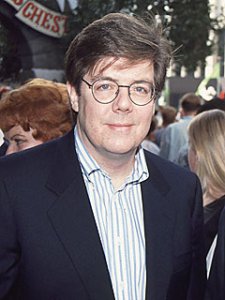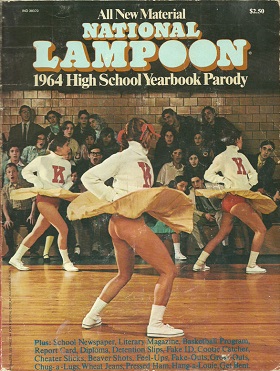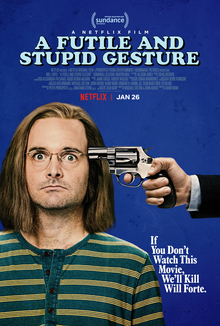
National Lampoon was an American humor magazine that ran from 1970 to 1998. The magazine started out as a spinoff from The Harvard Lampoon.

Patrick Jake O'Rourke was an American author, journalist, and political satirist who wrote twenty-two books on subjects as diverse as politics, cars, etiquette, and economics. Parliament of Whores and Give War a Chance both reached No. 1 on The New York Times bestseller list.

John Wilden Hughes Jr. was an American film director, producer and screenwriter. He began his career in 1970 as an author of humorous essays and stories for the National Lampoon magazine. He went on in Hollywood to write, produce and sometimes direct some of the most successful live-action comedy films of the 1980s. He directed such films as Sixteen Candles, The Breakfast Club, Weird Science, Ferris Bueller's Day Off, Planes, Trains and Automobiles, She's Having a Baby, and Uncle Buck; and wrote the films National Lampoon's Vacation, Mr. Mom, Pretty in Pink, The Great Outdoors, National Lampoon's Christmas Vacation, Home Alone, Dutch, and Beethoven.

Douglas Clark Francis Kenney was an American comedy writer of magazine, novels, radio, TV and film, who co-founded the magazine National Lampoon in 1970. Kenney edited the magazine and wrote much of its early material. He went on to write, produce, and perform in the influential comedies Animal House and Caddyshack before his sudden death at the age of 33.

Bernard Heinrich "Henry" Kroger was an American businessman who created the Kroger chain of supermarkets. Kroger was a pioneering grocery innovator who introduced self-service shopping to the public in 1895. He allowed customers to enter his stores, shop with prices clearly marked on every item, and take the merchandise home themselves instead of waiting for a delivery.
Thomas A. DeVilbiss High School was a public high school in Toledo, Ohio from 1931 to June 1991. It was part of the Toledo Public Schools, serving students from the DeVeaux, Elmhurst, Grove Patterson, Longfellow, Mayfair, McKinley, Nathan Hale, Old Orchard, and Whittier elementary schools. The building still sits at 3301 Upton Avenue near the Central Avenue intersection.
Charles H. Chuckovitz was an American professional basketball player in the 1930s and 1940s.

The Mid-American Conference Men's Basketball Player of the Year is an award given to the most outstanding men's basketball player in the Mid-American Conference (MAC). The award was first given following the 1967–68 season. Four players have won the award multiple times: Tom Kozelko, Ron Harper, Gary Trent and Bonzi Wells. Trent is the only player to have been honored as player of the year three times (1993–95). There have been no ties, nor has any player from the MAC ever won any of the national player of the year awards.
The Eldorado Gaming Scioto Downs Columbus Blue Jackets Radio Network is an American radio network consisting of 36 radio stations which carry coverage of the Columbus Blue Jackets, a professional hockey team in the National Hockey League.

National Lampoon 1964 High School Yearbook Parody is an American humor book that was first published in 1973. It was a spin-off from National Lampoon magazine. The book was a parody of a high school yearbook from the early 1960s.

Solar power in Ohio has been increasing, as the cost of photovoltaics has decreased. Ohio installed 10 MW of solar in 2015. Ohio adopted a net metering rule which allows any customer generating up to 25 kW to use net metering, with the kilowatt hour surplus rolled over each month, and paid by the utility once a year at the generation rate upon request. For hospitals there is no limit on size, but two meters are required, one for generation, the other for utility supplied power.
The 1960 Ohio Bobcats football team was an American football team that represented Ohio University during the 1960 NCAA College Division football season. In their third season under head coach Bill Hess, the Bobcats won the Mid-American Conference (MAC) championship, compiled a perfect 10–0 record, shut out five of ten opponents, and outscored all opponents by a combined total of 269 to 34. They played their home games in Peden Stadium in Athens, Ohio.

Robert E. Gerber was an American basketball player. He played in the National Basketball League for four seasons following an All-American college career at the University of Toledo.

A Futile and Stupid Gesture is a 2018 American biographical comedy-drama film based on Josh Karp's book of the same title, directed by David Wain, and written by Michael Colton and John Aboud. The film stars Will Forte as comedy writer Douglas Kenney, during the rise and fall of National Lampoon.
Accel Schools, styled ACCEL Schools, is a for-profit education management organization that operates 77 charter schools and 15 online schools primarily in Ohio. Accel schools have operated on significantly lower budgets than other Cleveland schools.










